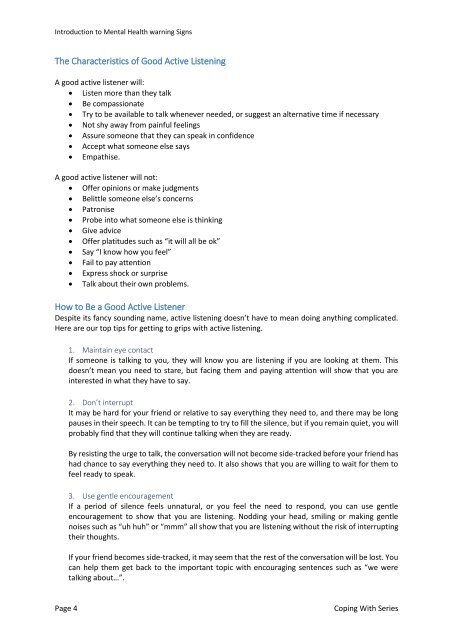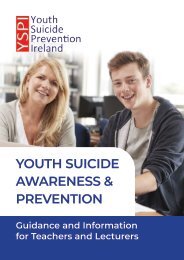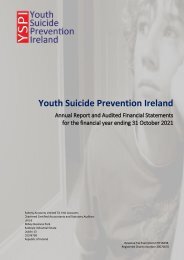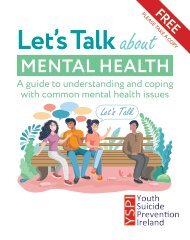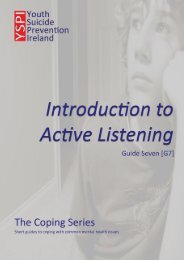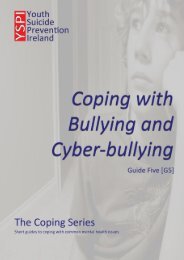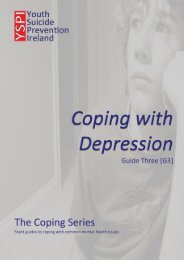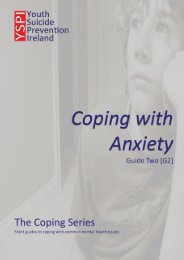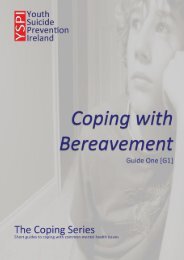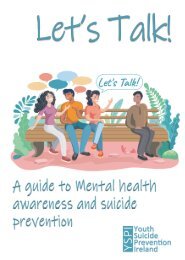CWSG6 - Introduction to Mental Health Warning Signs
This guide is part of the Coping With Series. Each guide provides an introduction to the issue, signs and symptoms to be aware of, coping techniques and information on helping friends and family to cope.
This guide is part of the Coping With Series. Each guide provides an introduction to the issue, signs and symptoms to be aware of, coping techniques and information on helping friends and family to cope.
- No tags were found...
Create successful ePaper yourself
Turn your PDF publications into a flip-book with our unique Google optimized e-Paper software.
<strong>Introduction</strong> <strong>to</strong> <strong>Mental</strong> <strong>Health</strong> warning <strong>Signs</strong><br />
The Characteristics of Good Active Listening<br />
A good active listener will:<br />
Listen more than they talk<br />
Be compassionate<br />
Try <strong>to</strong> be available <strong>to</strong> talk whenever needed, or suggest an alternative time if necessary<br />
Not shy away from painful feelings<br />
Assure someone that they can speak in confidence<br />
Accept what someone else says<br />
Empathise.<br />
A good active listener will not:<br />
Offer opinions or make judgments<br />
Belittle someone else’s concerns<br />
Patronise<br />
Probe in<strong>to</strong> what someone else is thinking<br />
Give advice<br />
Offer platitudes such as “it will all be ok”<br />
Say “I know how you feel”<br />
Fail <strong>to</strong> pay attention<br />
Express shock or surprise<br />
Talk about their own problems.<br />
How <strong>to</strong> Be a Good Active Listener<br />
Despite its fancy sounding name, active listening doesn’t have <strong>to</strong> mean doing anything complicated.<br />
Here are our <strong>to</strong>p tips for getting <strong>to</strong> grips with active listening.<br />
1. Maintain eye contact<br />
If someone is talking <strong>to</strong> you, they will know you are listening if you are looking at them. This<br />
doesn’t mean you need <strong>to</strong> stare, but facing them and paying attention will show that you are<br />
interested in what they have <strong>to</strong> say.<br />
2. Don’t interrupt<br />
It may be hard for your friend or relative <strong>to</strong> say everything they need <strong>to</strong>, and there may be long<br />
pauses in their speech. It can be tempting <strong>to</strong> try <strong>to</strong> fill the silence, but if you remain quiet, you will<br />
probably find that they will continue talking when they are ready.<br />
By resisting the urge <strong>to</strong> talk, the conversation will not become side-tracked before your friend has<br />
had chance <strong>to</strong> say everything they need <strong>to</strong>. It also shows that you are willing <strong>to</strong> wait for them <strong>to</strong><br />
feel ready <strong>to</strong> speak.<br />
3. Use gentle encouragement<br />
If a period of silence feels unnatural, or you feel the need <strong>to</strong> respond, you can use gentle<br />
encouragement <strong>to</strong> show that you are listening. Nodding your head, smiling or making gentle<br />
noises such as “uh huh” or “mmm” all show that you are listening without the risk of interrupting<br />
their thoughts.<br />
If your friend becomes side-tracked, it may seem that the rest of the conversation will be lost. You<br />
can help them get back <strong>to</strong> the important <strong>to</strong>pic with encouraging sentences such as “we were<br />
talking about…”.<br />
Page 4<br />
Coping With Series


